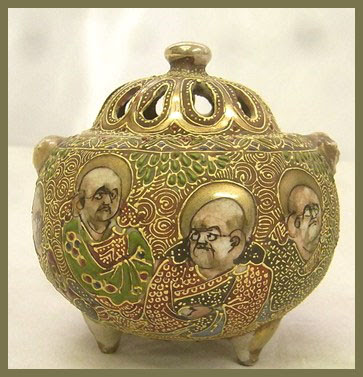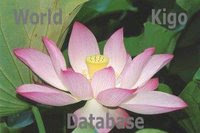:::::::::::::::::::::::::::::::::::::::::::::::::::::::::::::::::::::::::::::::::::::::::::::::::::::
Butsugai Fusen 物外不遷
1795~1867

Takeda Butsugai 武田 物外(たけだ もつがい)
寛政7年(1795年)3月 - 慶応3年11月25日(1867年12月20日)
He was a teacher of martial arts, a Zen monk, painter and wrote haiku. He was also skilled in Ikebana, Igo and Go, Tea ceremony, Calligraphy and other fine arts of his time.
Founder of the Fusen-Ryu 不遷流 (ふせんりゅう) of martial arts, which is still practised in Okayama prefecture, Japan.

© Photo : www.mable.ne.jp 物外和尚
Daruma painted by Butsugai at the temple Sosen-ji (Soosenji 宗泉寺) in Matsue City.
:::::::::::::::::::::::::::::::::::::::::::::::::::::::::::::::::::::::::::::::::::::::::::::::::::::

© Photo www.cpustudy.net/karate
Japanese Reference
:::::::::::::::::::::::::::::::::::::::::::::::::::::::::::::::::::::::::::::::::::::::::::::::::::::
Takeda Butsugai (also known or spelt as Takeda Genkotsu Motsugi) was born in Onomichi 3rd March 1794 (end of the Tokugawa Shogunate era).
When he was 6, his parents sent him to Ryutai Ji (竜泰寺)where he lived until he was 12. When he turned 12 he left the temple and began his martial arts training under the tai jutsu instructor of the Gei Shu Han, master Takahashiihyoei Mitsumasa. He achieved Menkyou kaiden of Nanba Ippo Ryu.
From age 19 to 30, he traveled throughout Japan studying Buddhism sword and pen. At 31 he became the head priest of the Saihouji Temple (済法寺). At the age of 12 years, Butsugai became a monk at the Denpuku-ji temple in Geishu (present day's Hiroshima City), a temple of the Sodo sect of Zen. Where he was then known as Takeda Butsugai Osho (Osho is a term of respect for a monk).
Takeda Butsugai was a child of Miki Heita, a retainer of Matsudaira Okinokami and Lord of Matsuyama-han (present day's Ehime Prefecture). He studied Nanba-ippo Ryu with Takahasi Inobei Mitsumasa and official Taijutsu (unarmed combat) instructor of Geishu, for about seven years and was awarded “Menkyo Kaiden”.
After this Butsugai travelled around many parts of Japan and kept studying in both literary and martial arts until the age of 30. On top of Nanba-Ippo Ryu, he studied Yoshin-ryu, Shibukawa Ryu, Kito-ryu, Takenouchi-ryu, Yagyu-ryu, Sekiguchi-ryu, etc. and, by adopting strong points of each style and created his style “Fusen-ryu”.
Butsugai died in 1867.
Japanese Reference
:::::::::::::::::::::::::::::::::::::::::::::::::::::::::::::::::::::::::::::::::::::::::::::::::::::
His Grave at temple Saiho-ji (Saihooji)
Hiroshima, Onomichi
Genkotsu Osho 拳骨和尚
The temple also keeps a go board and the chain he liked to use.
The temple is in a cliff area and has many Buddha statues carved the cliffs.

© PHOTO : 済法寺の紹介
極楽も 地獄も照らす初日かな
gokuraku mo jigoku mo terasu hatsuhi kana
the first sun -
shines on paradise
shines on hell

:::::::::::::::::::::::::::::::::::::::::::::::::::::::::::::::::::::::::::::::::::::::::::::::::::::
. . . . . H A I K U
Memorial Stone in Onomichi, Temple Senkoji Park
千光寺公園

あれは伊予こちらは備後春の風
are wa Io kochira wa Bingo haru no kaze
there is Io
here is Bingo
spring breeze
Io and Bingo are placenames of areas in Western Japan.
Butsugai was born in Io (now near Matsuyama, Shikoku), but spent his last years in Onomichi (Bingo), from the hills you can almost see Io on the other side of the sea.
:::::::::::::::::::::::::::::::::::::::::::::::::::::::::::::::::::::::::::::::::::::::::::::::::::::

Look at one more scroll !
© www.kihindo.jp
煤掃や第一番に腹のうち
suzu haki ya dai ichiban ni hara no uchi
Year End cleaning -
first thing to clean
your own self
:::::::::::::::::::::::::::::::::::::::::::::::::::::::::::::::::::::::::::::::::::::::::::::::::::::

© www.yamaguchi-bijutukurabu
淵明に ひとりではなし 菊の花
enmei ni hitori de wa nashi kiku no hana
with Enmei
I am not alone -
chrysanthemums in bloom
To Enmei, Chinese poet 365~427
:::::::::::::::::::::::::::::::::::::::::::::::::::::::::::::::::::::::::::::::::::::::::::::::::::::
古池や何万育つ蛙の子
furu ike ya nanman sodatsu kaeru no ko
this old pond -
home to quite a few thousand
little frogs
秋の暮障子明けても我ひとり
aki no kure shooji akete mo ware hitori
autumn evening
even when I open the sliding doors
I am all alone
天地の力こぶなり梅の花
何処に富士もっと仰向け雲の上
http://www.mable.ne.jp/~sin/page053.html
世を背に独り楽しむ蓮の花
yo o sei ni hitori tanoshimu hasu no hana
the world left behind
all alone I enjoy
the flowers of lotus
滝の音とめて鳴きけりほととぎす
taki no oto tomete nakikeri hototogisu
the sound of a waterfall
stops and it sings ,
the little cuckoo
花守と人はいふらん庵ひとり
http://www.mable.ne.jp/~sin/page051.html
List of his haiku about SPRING
http://izayohi.hp.infoseek.co.jp/kusyu1.html
Tr. Gabi Greve
:::::::::::::::::::::::::::::::::::::::::::::::::::::::::::::::::::::::::::::::::::::::::::::::::::::
Tansaku by Butsugai, owned by Jake Benson
Introduced with permission of Jake, February 2008
Click for enlargement !
Inscription on the back: Butsugai
Thanks to the kind help of Kiyoshi Imai and his father, Rev. Kazuto Imai, the haiku on the tansaku could be read and translated.
雪達磨おびを解きて我すてず
yuki daruma obi o tokite ware sutezu
snowman Daruma -
he wears no loincloth,
but has not lost his mind
その意味は 「雪達磨、下帯(ふんどし)も脱いでいるが、我(人間性)を失っていない。」ということではないか。
Imai Sensei, arigato! Jake, arigato!
Fundoshi Loincloth and Daruma
:::::::::::::::::::::::::::::::::::::::::::::::::::::::::::::::::::::::::::::::::::::::::::::::::::::
Not to mix Butsugai with another painter
Wakasa Butsugai Seigyoo
若狭 物外 成業(わかさ せいぎょう)
(1887~1957)
He was born in Akita Pref. in 1887.
:::::::::::::::::::::::::::::::::::::::::::::::::::::::::::::::::::::::::::::::::::::::::::::::::::::::::::::::::::::::::::
[ . BACK to DARUMA MUSEUM TOP . ]
[ . BACK to WORLDKIGO . TOP . ]
:::::::::::::::::::::::::::::::::::::::::::::::::::::::::::::::::::::::::::::::::::::::::::::::::::::::::::::::::::::::::::















































